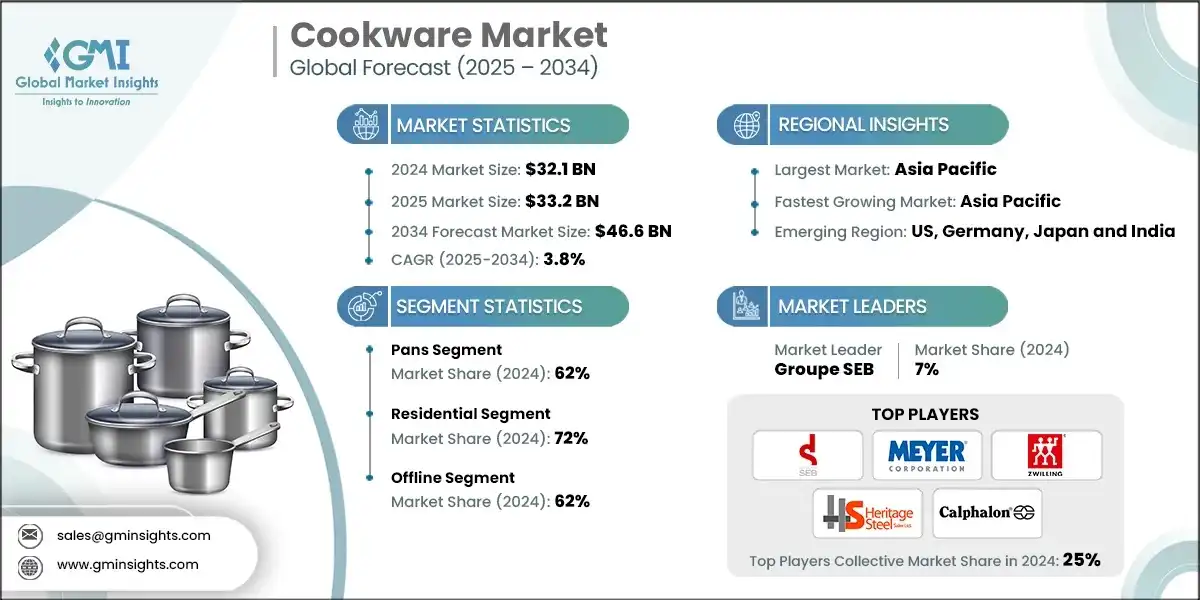Cookware Market Size
The global cookware market is forecasted to grow significantly, with an estimated size of USD 32.1 billion in 2024. This figure is expected to expand to USD 46.6 billion by 2034, representing a compound annual growth rate (CAGR) of 3.8%, according to Global Market Insights Inc. This growth reflects a burgeoning interest in home cooking, health consciousness, and innovation in cookware technologies.

The market’s expansion can be largely attributed to shifting consumer behaviors and cooking trends. As more people embrace home cooking, driven by the influence of cooking shows, social media chefs, and a focus on healthy eating, demand for high-quality cookware has surged.
Market Drivers and Trends
-
Increased Interest in Home Cooking:
The culinary world has witnessed a renaissance, with consumers more invested in preparing meals at home. The rise of cooking shows and social media culinary influencers contributes to this trend. Consumers are increasingly conscious of the benefits of cooking with safe, non-toxic materials, prompting them to seek out premium products. -
Rise of Smart Cookware:
Technology is making its mark in the kitchen. The introduction of smart cookware enhanced with IoT technology, equipped with sensors and mobile app connectivity, has transformed cooking experiences. Consumers can now monitor cooking times and temperatures remotely, making meal preparation much more efficient and precise. -
Shift Towards Sustainable Products:
The cookware industry is increasingly turning to eco-friendly materials. There is a demand for products that utilize recycled materials, non-toxic ceramics, and sustainable practices, reflecting a broader trend of environmental awareness among consumers. -
Growth of Online Retail:
The accessibility of online shopping has exploded in recent years, with consumers favoring the convenience it offers. This shift has contributed to higher sales figures, particularly in regions with growing internet access and e-commerce capabilities.
Market Segmentation
By Product:
- Pans hold a dominating market share of 62% in 2024, with a CAGR over 4% anticipated from 2025 to 2034. The versatility of pans, used for various cooking techniques, has made them a staple in many kitchens.
- Pots and bakeware follow, catering to specific cooking styles, but with comparatively lower market shares.
By End-User:
- The residential sector leads with a 72% market share, driven by health consciousness and the booming home cooking movement. Consumers are willing to invest in quality cookware for everyday culinary adventures.
- The commercial sector, though important, shows slower growth due to longer replacement cycles and bulk purchasing patterns.
By Distribution Channel:
- The offline segment remains pivotal, capturing 62% of the market share as consumers prefer to engage physically with products before making a purchase.
- However, the online segment is thriving, expected to grow at the highest CAGR of 4.1% due to shifting consumer preferences towards digital shopping.
Regional Insights
Asia-Pacific is not only the largest market but also the fastest-growing region in the cookware industry. With rising populations and a considerable middle-class segment willing to invest in quality cooking products, the demand for premium cookware is expected to skyrocket.
Market Leaders
- Groupe SEB is at the forefront with a 7% market share, recognized for its diverse product lineup that encompasses both budget and premium segments.
- Other noteworthy competitors include Meyer Corporation, Zwilling, Heritage Steel, and Calphalon, collectively holding about 25% of the market.
Emerging Trends
The cookware market is evolving with several key trends shaping its future:
-
Sustainability and Eco-Friendly Products:
The transition towards non-toxic, eco-friendly materials is reshaping product development. Companies are increasingly incorporating transparency about sourcing and certification in their marketing strategies. -
Smart Technologies:
Cookware equipped with IoT features, capable of automatic adjustments based on cooking variables, is gaining traction. This innovation not only appeals to tech-savvy consumers but also enhances cooking outcomes. -
E-commerce Expansion:
The shift towards online shopping continues to grow, fueled by improved digital marketing and logistics. This trend is reshaping distribution strategies beyond traditional retail environments.
Cookware Market Analysis
The cookware market is expected to evolve significantly, especially with consumers seeking multifunctional, sustainable products. As health consciousness and home cooking trends continue to flourish, along with the demand for technologically advanced kitchenware, manufacturers have the opportunity to market innovative solutions that cater to the modern chef.
With such promising growth trajectories, the cookware market is poised for a robust upward trend in the coming decade, driven by changing consumer preferences, advancements in technology, and heightened awareness of sustainability.
Market Developments
Recent collaborations and product launches signify active engagement from leading players in the cookware sector. For example, Groupe SEB’s acquisition of La Brigade de Buyer enhances its position in the premium cookware category, while heritage-focused brands like Heritage Steel and GoodCook continue to innovate with eco-friendly options.
This strategic focus on sustainable, quality products paired with the integration of technology will likely propel the industry forward, meeting the demands of an increasingly discerning consumer base.
The cookware market landscape reflects a dynamic convergence of tradition and innovation, highlighting the crucial role cooking plays in our daily lives as well as the products that facilitate it.